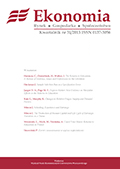Polish and Swedish Fiscal Policy
in the Years 1772-1792.
A Short-Run Analysis
P. Koryś, M. Tymiński
ABSTRAKT: This paper compares Poland and Sweden in the second half of eighteenth
century, as two, poorly developed, agrarian countries. Sweden secured its
existence, but Poland did not manage to break out of a political dependency
and ultimately vanished from the map. We would like to discuss the
causes of these different outcomes. Contemporary interpretations underline
the role of reasonable fiscal policy. We argue that in this particular case
this explanation is insufficient. Contrary to that, our analysis shows that in
the context of short term political risks, expansive fiscal policy which led
to unpayable debt may be more justifiable than policy of balanced budget.
Pełny tekst (PDF)
Numer wydania: 33
W numerze:
R&D Offshoring to Emerging Economies:
Can Poland compete?
T. Mroczkowski
ABSTRAKT |
PDF
Economists have analyzed offshore outsourcing mainly from the perspective
of transaction costs and procurement decisions. In the current phase of
globalization offshoring practice increasingly involves high value added activities
such as design and R&D. Today’s globalized R&D system embraces
increasingly capable emerging economies that offer firms new options
in terms the offshoring not just development but also research functions.
However the offshoring of R&D to emerging economies entails higher levels
of risk and uncertainty. The literature review shows that problems associated
with this kind of R&D offshoring have seen few studies and are not
well understood – especially in a comparative perspective of the practices
of companies based in different countries with distinctive business philosophies.
Some evidence points to differences in the offshoring practices of US
companies – as “globalization leaders”– with those of German companies
as “reluctant globalizers”. The paper reports the preliminary results of an
ongoing study of offshoring of pharmaceutical and biotechnology R&D to
emerging economies. In this study we compare clinical trials destinations
chosen by US and German companies – using the American government
clinical trials database. We find interesting differences which however do
not support the hypothesis that German companies are less aggressive about
offshoring clinical trials than US based ones. We also look at the position of
Poland as a site for offshored R&D and make recommendations about how
the country could improve its competitiveness in this domain in the future.
To Rent or to Buy – Analysis of Housing Tenure Choice Determined by Housing Policy
H. Augustyniak, J. Łaszek, K. Olszewski, J. Waszczuk
ABSTRAKT |
PDF
The article discusses the relatively large share of owner-occupied housing
in the housing stock in selected European countries with relatively low per
capita income and describes the underlying causes of this phenomenon. We
also identify the economic implications of the growing number of owneroccupied
housing and poorly developed rental market. The paper analyses
home purchase or rental decisions and explains the correlations between
housing availability, consumption and households’ savings, as well as housing
policy and investigates this question empirically. The way in which the
development of the rental market can improve the situation in the property
market is presented on the basis of a simple model.
FFR Level in the Period 2000-2007
and the Emergence of the Asset Price Bubble
on the US Real Estate Market
M. Karaś
ABSTRAKT |
PDF
This article aims at investigating the impact of the level of the Fed funds
rate in the United States in the period 2000-2007 on the emergence of the
asset price bubble on the US real estate market, burst of which triggered
the financial crisis in the US and globally. Rather than constructing a single
theoretical or empirical model of this potential influence, a more eclectic
approach is taken. The argument is structured around three fundamental
questions (1) whether the Fed funds rate had been low compared to benchmarks
in the given period; (2) whether low short-term rate itself had been
able inflate a real estate bubble; (3) whether alternative explanations of the
bubble causes were sufficient. For each of the issues a number of qualitative
explanations and quantitative models is provided and analysed. Based on
the gathered data, models, and arguments, the paper concludes that the influence
of the Fed funds rate on the bubble’s emergence is not to be underestimated.
This conclusion should be kept in mind in the context of future
directions for monetary policy in the US and globally, as the extremely low
interest rates applied by central banks to date might be inflating the next
bubble.
Polish and Swedish Fiscal Policy
in the Years 1772-1792.
A Short-Run Analysis
P. Koryś, M. Tymiński
ABSTRAKT |
PDF
This paper compares Poland and Sweden in the second half of eighteenth
century, as two, poorly developed, agrarian countries. Sweden secured its
existence, but Poland did not manage to break out of a political dependency
and ultimately vanished from the map. We would like to discuss the
causes of these different outcomes. Contemporary interpretations underline
the role of reasonable fiscal policy. We argue that in this particular case
this explanation is insufficient. Contrary to that, our analysis shows that in
the context of short term political risks, expansive fiscal policy which led
to unpayable debt may be more justifiable than policy of balanced budget.
Gender Equality as the Determinant of FDI Flows
to Central European Countries
M. Brzozowski
ABSTRAKT |
PDF
The purpose of this paper is to asses the weight of human capital and gender
equality in explaining the bilateral FDI inflows to 11 Central European
economies. The group comprises the ten countries that acceded to the EU
in 2004 or 2007 and Croatia which is a candidate country since 2004. The
focus on the region is justified by the fact that the European Commission
acknowledged that fostering human capital development and gender equality
is a condition of economic development. The period under investigation
encompasses 2000-2009 and includes both the global FDI flows peak
achieved in 2007 as well as the two years of sharp declines in 2008 and
2009. If FDI is mostly low-cost seeking oriented, however, gender inequality
in health and access to education may create a pool of low-pay workers
that can be profitably exploited unless the level of productivity is not seriously
hindered by gender disparities. In this paper I argue that women’s
representation in parliaments is another aspect of the gender gap that may
shape foreign investors decisions. These hypotheses are verified in the
framework of a standard gravity model using System Generalized Method
of Moments technique.
Comparison of Alternative Approaches
to VaR Evaluation
M. Łupiński
ABSTRAKT |
PDF
The main goal of this article is to present alternative methods of market risk
measurement in Polish banking sector with popular Value at Risk (VaR)
approach. Four main methods: analytical, historical, simulation and hybrid
(Filtered Historical Simulation, FHS) of VaR are presented and then three
of them are applied to evaluate interest risk stemming from government
bonds’ portfolio held by Polish banks. Adequacy of VaR measures counted
with particular methods is compared with the help of formalized criteria
and best fitted methodology is recommended.

